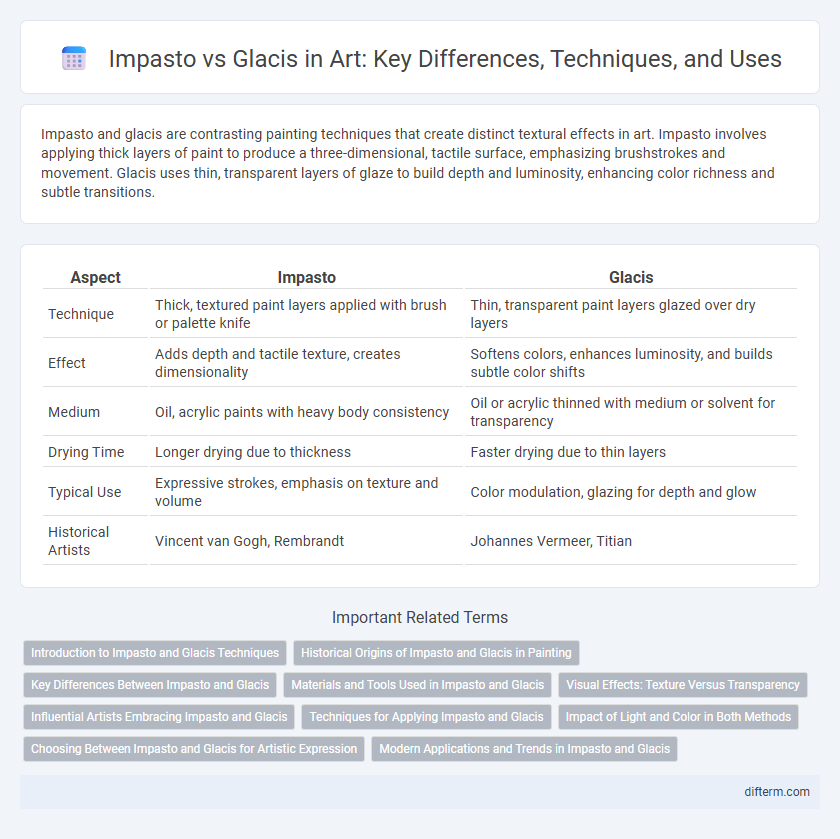Impasto and glacis are contrasting painting techniques that create distinct textural effects in art. Impasto involves applying thick layers of paint to produce a three-dimensional, tactile surface, emphasizing brushstrokes and movement. Glacis uses thin, transparent layers of glaze to build depth and luminosity, enhancing color richness and subtle transitions.
Table of Comparison
| Aspect | Impasto | Glacis |
|---|---|---|
| Technique | Thick, textured paint layers applied with brush or palette knife | Thin, transparent paint layers glazed over dry layers |
| Effect | Adds depth and tactile texture, creates dimensionality | Softens colors, enhances luminosity, and builds subtle color shifts |
| Medium | Oil, acrylic paints with heavy body consistency | Oil or acrylic thinned with medium or solvent for transparency |
| Drying Time | Longer drying due to thickness | Faster drying due to thin layers |
| Typical Use | Expressive strokes, emphasis on texture and volume | Color modulation, glazing for depth and glow |
| Historical Artists | Vincent van Gogh, Rembrandt | Johannes Vermeer, Titian |
Introduction to Impasto and Glacis Techniques
Impasto technique involves applying thick layers of paint to create texture and depth, often emphasizing brushstrokes and the physicality of the medium. Glacis, on the other hand, uses thin, transparent layers of paint to build luminosity and subtle color variations, enhancing light and shadow effects. Both techniques offer distinct approaches to surface manipulation and visual impact in painting.
Historical Origins of Impasto and Glacis in Painting
Impasto, originating in the Renaissance period, was popularized by artists like Rembrandt to create texture and emphasize brushstrokes, enhancing the tactile quality of paintings. Glacis, developed during the Renaissance and Baroque eras, involves applying multiple translucent paint layers to achieve depth and luminosity, famously used by artists such as Titian and Vermeer. These contrasting techniques reflect historical innovations in manipulating paint to produce distinct visual effects and emotional impact.
Key Differences Between Impasto and Glacis
Impasto involves applying thick layers of paint to create texture and dimension, emphasizing brushstrokes and physicality on the canvas. Glacis, or glazing, uses thin, transparent layers of paint to build depth and luminosity without altering the surface texture significantly. The key difference lies in impasto's tactile, sculptural effect versus glacis' smooth, subtle color modulation.
Materials and Tools Used in Impasto and Glacis
Impasto technique requires thick, textured paints often created with heavy-bodied oil or acrylics, applied using palette knives or stiff brushes to build visible, three-dimensional layers. In contrast, glacis involves thin, transparent layers made from diluted oil paints or glazes applied with soft brushes, enhancing luminosity and depth through multiple translucent coatings. These material and tool choices directly influence the tactile quality and visual effects distinctive to impasto and glacis paintings.
Visual Effects: Texture Versus Transparency
Impasto creates a rich, tactile surface by applying thick layers of paint that enhance light reflection and shadow depth, producing a dynamic, three-dimensional effect. Glacis involves thin, transparent layers that build luminous color depth and subtle gradations, allowing underlying details to remain visible and creating a glowing, ethereal quality. Comparing texture versus transparency, impasto emphasizes physicality and bold strokes, while glacis prioritizes delicate light modulation and chromatic refinement.
Influential Artists Embracing Impasto and Glacis
Influential artists such as Vincent van Gogh and Rembrandt van Rijn have prominently embraced impasto techniques to add texture and emotional intensity to their works, enhancing the visual impact through thick, expressive brushstrokes. In contrast, masters like Johannes Vermeer and Jean-Baptiste-Simeon Chardin utilized glacis to achieve delicate luminosity and depth by applying thin, translucent layers of paint. The strategic use of impasto and glacis by these artists has significantly shaped the evolution of painting styles and techniques in Western art history.
Techniques for Applying Impasto and Glacis
Impasto technique involves applying thick layers of paint with palette knives or stiff brushes to create textured surfaces that catch light and add dimension to artwork. Glacis relies on thin, transparent layers of oil paint applied with soft brushes to build depth and luminosity through subtle color glazing. Mastery of brush pressure and paint consistency is essential for controlling texture in impasto and achieving smooth, even glazing in glacis.
Impact of Light and Color in Both Methods
Impasto techniques create textured surfaces that catch and reflect light, producing vibrant highlights and deep shadows, enhancing color intensity and depth. Glacis layers use thin, translucent washes that allow light to penetrate and reflect from underlying colors, resulting in luminous, subtle color modulation. The interplay of light with impasto's tactile peaks contrasts with glacis' smooth, radiant glazes, defining their unique visual impact in painting.
Choosing Between Impasto and Glacis for Artistic Expression
Impasto creates texture by applying thick layers of paint, enhancing physicality and dynamic light reflection in artwork, while glacis uses thin, transparent layers to achieve depth and luminosity through subtle color blending. Artists choose impasto to emphasize bold brushstrokes and emotional intensity, whereas glacis suits delicate tonal transitions and atmospheric effects. Understanding these contrasting techniques allows for deliberate artistic expression tailored to desired visual impact and narrative.
Modern Applications and Trends in Impasto and Glacis
Modern applications of impasto emphasize texture and three-dimensional effects, with contemporary artists using heavy-bodied acrylics and palette knives to create expressive, tactile surfaces. Glacis techniques have evolved with synthetic glazes and mixed media, allowing for luminous layering and enhanced color depth in abstract and figurative works. Emerging trends combine both methods, blending impasto's bold textures with glacis' subtle translucency to explore contrast and dynamic visual interest in modern art.
impasto vs glacis Infographic

 difterm.com
difterm.com